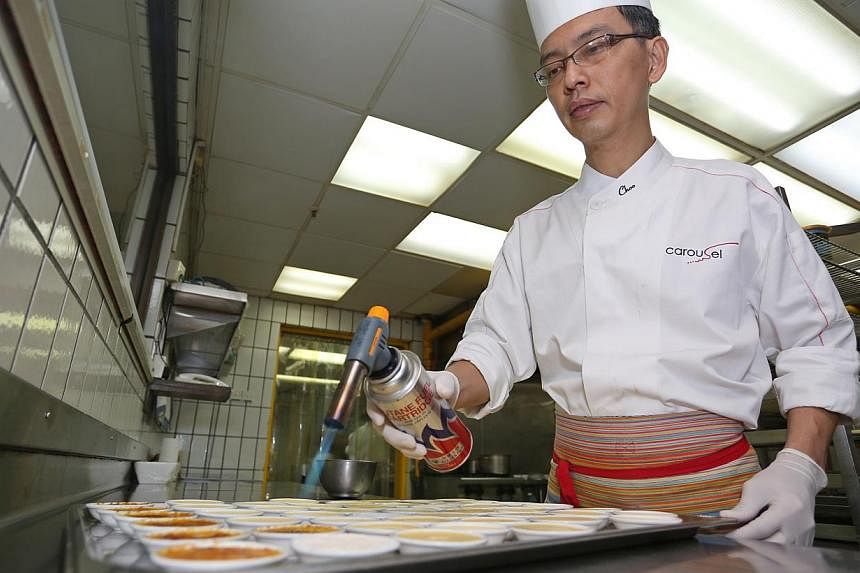The Fullerton Bay Hotel has stopped using kitchen blowtorches in its dining rooms, following an accident last Sunday, when a diner at its Clifford restaurant was burnt by the flame from one of these torches.
It was being used to caramelise sugar on a creme brulee dessert in its buffet spread.
The Australian woman, who was dining with her mother, suffered second-degree burns on her right shoulder, ear and face.
SundayLife! understands that she has been discharged from hospital.
Mr Giovanni Viterale, general manager of The Fullerton Heritage group of hotels, which includes The Fullerton Bay Hotel Singapore, says: "We have put an immediate stop to using such equipment at Clifford and all our dining establishments. The hotel remains in close contact with the guest and her family and are rendering our full assistance in her recovery."
The hotel will use the blowtorches only in its kitchens.
The handheld tools produce an intense flame using butane gas. They are commonly used by chefs to caramelise the sugar on a creme brulee dessert, sear meat and melt cheese or other toppings. The flame can reach temperatures of about 200 deg C.
Yet, other food and beverage establishments that SundayLife! spoke to say they will continue using the blowtorches, whether it is in the kitchen or in front of diners - as they ensure staff are trained and safety precautions are taken when using them.
Capella Singapore's executive chef David Senia says: "The incident has served as a reminder for all F&B personnel to make the safety and comfort of our guests the utmost priority. The blowtorch is a very simple device to use, but precautions are necessary, especially when dealing with a flammable object."
At the hotel's The Knolls restaurant, the blowtorch is used for some Japanese dishes, as well as brunch favourite Eggs Benedict. It is used only in the kitchen.
Over at the Shangri-La Hotel Singapore, the kitchen blowtorch is used in its pastry kitchen and buffet restaurant The Line. Its creme brulee dessert is torched within the "live theatre kitchen" section at the restaurant, but away from diners.
The hotel's executive chef Nicola Coccia says: "All new colleagues joining the pastry team must be trained by a senior chef on how to handle the torch with maximum supervision and safety precautions.
"The kitchen in itself is a very hazardous environment, but this does not prevent us from cooking."
In Japanese restaurants, the blowtorch is commonly used to torch or sear food such as fatty tuna or otoro.
The Akashi Group's chef-owner Mervin Goh, whose restaurants include Akashi and robatayaki restaurant Akanoya, both at Orchard Parade Hotel, says: "We use the blowtorch very minimally on sushi, including those topped with otoro, marbled beef and fatty salmon. The blowtorch is always turned away from anyone or anything within a certain distance before the flame is turned on. Once the flame is on, it is used for 10 to 15 seconds."
At Hashida Sushi in Mandarin Gallery, all torching of ingredients is done in the kitchen.
Chef-owner Kenjiro Hashida says: "It is safer to do the torching in the kitchen instead of in front of diners sitting at the counter. You never know if the torch may not be working properly or if diners lean too close to watch what we are doing. Similarly, we are also careful about not placing our knives too close to diners, in case they want to touch them."
In bars, bartenders have to be extra cautious when using the blowtorch because they are surrounded by flammable alcohol.
Jekyll & Hyde's head bartender Jeff Ho, 36, says: "We use the blowtorch to char ingredients or caramelise sugar as part of our cocktail preparation. It is used only behind the bar so that it is far away from guests."
Some restaurants even torch food tableside, and they include casual seafood chain The Manhattan Fish Market, and TungLok Group's Cajun-style seafood restaurant Dancing Crab at The Grandstand.
At The Manhattan Fish Market, staff torch the restaurant chain's signature Manhattan Flaming Prawns by tableside.
One of the menu highlights at Dancing Crab is Flaming Moonshine Tiger Prawns, where live prawns are soaked in alcohol, cooked in a heated ceramic pot and heated to between 26 and 30 deg C before it is flambeed.
Mr Norman Hartono, its marketing and communications manager, says: "Only senior staff are allowed to flambe the prawns at tableside, and have to do so at least 1m away from any table or people. If someone comes too close, staff have to pause the cooking of the prawns until the 'safety area' is maintained again.
"We will not consider stopping our practice of cooking tableside as the cooking method of flambeing has been around for decades. With precautions observed, we are confident of carrying out the process safely."
The Singapore Civil Defence Force says that apart from the Clifford case, it has had no recent reports of incidents involving what it calls "kitchen lighters".
Although the tools are commonly known as kitchen blowtorches, the SCDF makes the distinction between blowtorches used in industrial settings for welding, cutting and sealing, and which can reach temperatures of up to 1,200 deg C, and these kitchen lighters.
A spokesman says: "In general, all open flame activities such as those used for cooking, heating and warming must be carried out in the kitchen area and not at other places such as dining areas, buffet counters and bar counters.
"However, there are permissible exceptions such as cooking demonstrations at shopping centres and buffet counters. Organisers of such events are required to apply for a Temporary Permit from the SCDF."
Apart from being used in professional kitchens, kitchen blowtorches are also popular among home cooks. Ms Grace Tan, director of homeware store Tools of The Trade (ToTT) in Dunearn Road, notes a growing trend of customers buying blowtorches.
She says: "With proper care and usage, these kitchen tools can enhance the culinary experience of budding home cooks and baking enthusiasts, allowing them to create restaurant-style food in the comfort of their own homes."
Customers are advised to use the right-sized torch for the right job. For example, smaller ones are good for torching creme brulee and fish for sushi, while larger ones are good for searing big cuts of meat, she says.
Miss Yong Zi Qi, 19, a third-year culinary and catering management student at Temasek Polytechnic, owns a small blowtorch, which she calls her "precious tool".
She says: "It is easy and safe to use, and I make sure to point the flame away from the surroundings. I use it for creme brulee and to light the cooking stove. I'm also careful to store it away from the stove."
Business undergraduate Nicolas Ng, 21, who uses his blowtorch for creme brulee or searing salmon and steak, says: "I steer clear of people when using the torch. I'm not scared of chefs using it in restaurants. I like it when they do so. It's pretty cool."


